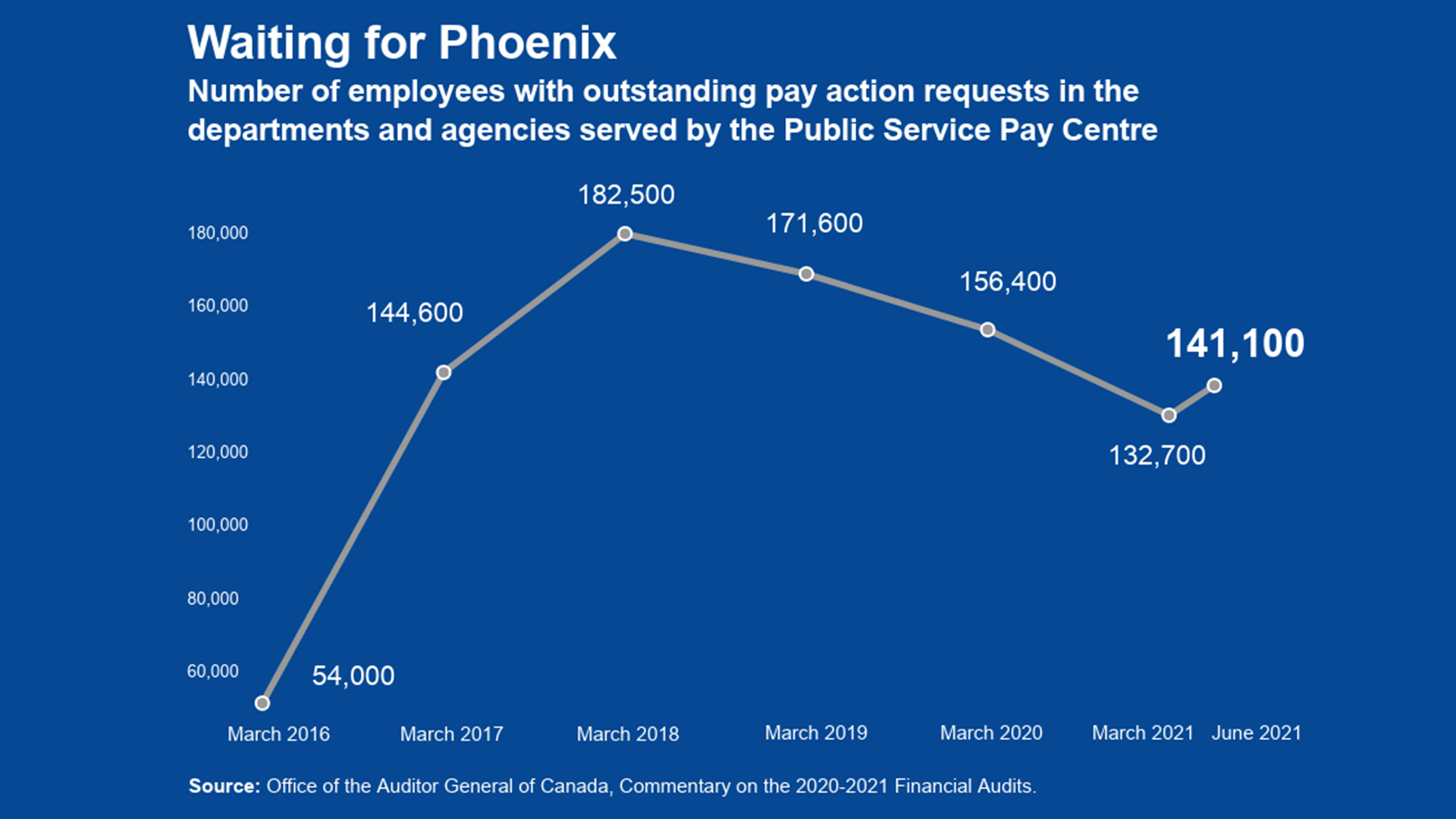
Thousands of workers are still owed money when they leave or retire from Canada’s public service, and some are still waiting years to get paid. Thousands more move to jobs in other departments and wait months, if not years, for their paperwork to catch up with them.
It’s been six years – and more than $1.4 billion in fixes – since the disastrous Phoenix launch. The government wanted the pay system to be stabilized this year, meaning the backlog of erroneous pay cases would be eliminated permanently. It’s not there yet.
The spotlight on the Phoenix fiasco all but disappeared when the pandemic took the national stage and the number of pay hardship cases fell. The errors that remain aren’t as egregious as they were in the early days when people were getting underpaid or overpaid massively, or not paid at all. However, despite improvements, a backlog of trouble remains.
The Office of the Auditor General found an overall error rate of 47 per cent in the pay of employees it sampled in 2020-21. That’s slightly lower than the 51 per cent error rate the prior year. It also flagged that 41 per cent still had pay errors waiting to be fixed at the end of the year – compared to 31 per cent the year before.
With $910 million in funding in 2020, Public Services and Procurement Canada (PSPC) put together a three-year plan to get rid of the backlog by December 2022.
The backlog-reduction strategy was built around using technology, boosting the productivity of pay advisers and reducing the volume of cases coming in. The idea is to help pay advisers plow through the flow of transactions every pay cycle and also have enough time to work on the backlog.
The size of the backlog steadily decreased for more than two years, from the peak in January 2018 of 384,000 transactions, to a low of 98,000 in April 2021. The number of people affected dropped. The pay centre also improved its wait times, meeting the service standard of dealing with most pay requests within 20 days at least 80 per cent of the time.
Ottawa races to collect Phoenix overpayments before deadline
Moving in and out of the public service shouldn’t be so hard
But then it started to backslide.
Phoenix’s processing started to hiccup and sputter for a couple of months before it inched back up throughout the summer and fall of 2021. The active backlog of transactions settled at 141,000 cases by late January 2022.
“When it comes to Phoenix, it is two steps forward, one step back. The backlog of outstanding transactions has reduced since 2016, but whenever a new collective agreement or MOU is signed, it slows down the progress,” said Dany Richard, president of the Association of Canadian Financial Officers.
PSPC officials argued the backslide was nothing more than the normal flux in the volume of work.
They said the number of transactions processed each month varies depending on the complexity of transactions, the pay centre’s capacity, any new collective agreements being implemented, and the normal seasonal spikes in demand, such as hiring summer students.
The size of the public service has also grown 24 per cent since 2015 and there’s been a considerable amount of churn – with people moving in and out of jobs, creating more transactions.
“Although we have made significant progress this past year in reducing the number of transactions in the backlog and queue from 2016-2020, we have seen an increase in new transactions received at the pay centre in 2021, which challenged our ability to reduce the backlog,” said PSPC spokesperson Michèle LaRose in an email.
Some say public servants, many safely working from home, aren’t complaining as loudly about pay errors when so many Canadians lost their jobs during the COVID-19 crisis. Some argue that unions backed off on Phoenix after winning $560 million in damages to compensate workers for pay gaffes. Others say public servants are now so used to pay errors that they have simply become inured to them.
“As the backlog of Phoenix pay issues continues to grow, it seems the government has quietly accepted that Phoenix can’t be fixed, “said Chris Aylward, president of the Public Service Alliance of Canada.”
“We’re nearing the six-year anniversary of the Phoenix fiasco, and thousands of workers are still having pay problems while waiting years for their previous issues to be resolved…Over the past few months, we’re seeing more and more members turn to us for help.”
The auditor general found that 141,100 employees had at least one outstanding “pay action request” last June, down from more than 182,000 in 2018.
The improvements made to Phoenix came partly through technology, such as automating retroactive payments like backpay for 2018 collective agreements. Processes were streamlined, programs introduced to speed up processing of routine work. This was all aimed at freeing up pay advisers to be deployed on the backlog.
The next focus was the culture change around timeliness and accuracy, which should have happened before Phoenix was launched. Managers, human resource and employees had to learn how to manage pay differently. The old pay system could handle late transactions – largely because pay advisers manually fixed things. But Phoenix runs in real time and can’t digest late or after-the-fact transactions.
That cultural shift from late to on-time transactions is slowly taking hold but problems remain around the timeliness and accuracy of requests for terminations and transfers.
At last count, 30,000 terminations were waiting to be processed, either in the queue or dumped into the backlog after the 45-day service standard is missed. Terminations are issued for anyone who leaves the public service.
About 34 per cent of the cases in backlog are less than a year old, but 12 per cent are more than four years old and the rest are between one and four years old. Employees could be owed vacation pay, overtime, allowances and/or severance pay.
About 10,000 transfers are waiting to catch up with employees in their new departments. Those who move to new jobs with raises or promotions could wait months or years for that extra money to kick in – and then discover they have other pay adjustments such as higher pension premiums.
Overpayments are another headache. Departments are racing to recover salary overpayments to employees in 2016, when Phoenix went live. By law, the government has six years to collect salary overpayments from employees – after which they become unrecoverable and are written off as debt. The government has collected about $2.3 billion so far but has another $552 million to collect.
Sources familiar with Phoenix say the problems dogging the system can be fixed with more pay advisers. PSPC has already quadrupled its pay workforce— to about 2,500 people—since Phoenix was launched.
This article was produced with support from the Accenture Fellowship on the Future of the Public Service. Read Kathryn May’s previous articles on the future of the public service.









